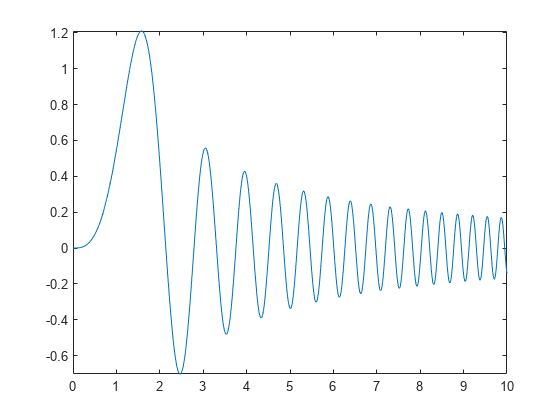Integration
This example shows how to compute definite integrals using Symbolic Math Toolbox™.

Definite Integral
Show that the definite integral for on is 0.
syms x
int(sin(x),pi/2,3*pi/2)ans =
Definite Integrals in Maxima and Minima
To maximize for , first, define the symbolic variables and assume that :
syms a x assume(a >= 0);
Then, define the function to maximize:
F = int(sin(a*x)*sin(x/a),x,-a,a)
F =
Note the special case here for . To make computations easier, use assumeAlso to ignore this possibility (and later check that is not the maximum):
assumeAlso(a ~= 1); F = int(sin(a*x)*sin(x/a),x,-a,a)
F =
Create a plot of to check its shape:
fplot(F,[0 10])

Use diff to find the derivative of with respect to :
Fa = diff(F,a)
Fa =
The zeros of are the local extrema of :
hold on fplot(Fa,[0 10]) grid on

The maximum is between 1 and 2. Use vpasolve to find an approximation of the zero of in this interval:
a_max = vpasolve(Fa,a,[1,2])
a_max =
Use subs to get the maximal value of the integral:
F_max = subs(F,a,a_max)
F_max =
The result still contains exact numbers and . Use vpa to replace these by numerical approximations:
vpa(F_max)
ans =
Check that the excluded case does not result in a larger value:
vpa(int(sin(x)*sin(x),x,-1,1))
ans =
Multiple Integration
Numerical integration over higher dimensional areas has special functions:
integral2(@(x,y) x.^2-y.^2,0,1,0,1)
ans = 4.0127e-19
There are no such special functions for higher-dimensional symbolic integration. Use nested one-dimensional integrals instead:
syms x y int(int(x^2-y^2,y,0,1),x,0,1)
ans =
Line Integrals
Define a vector field F in 3D space:
syms x y z F(x,y,z) = [x^2*y*z, x*y, 2*y*z];
Next, define a curve:
syms t
ux(t) = sin(t);
uy(t) = t^2-t;
uz(t) = t;The line integral of F along the curve u is defined as , where the on the right-hand-side denotes a scalar product.
Use this definition to compute the line integral for from
F_int = int(F(ux,uy,uz)*diff([ux;uy;uz],t),t,0,1)
F_int =
Get a numerical approximation of this exact result:
vpa(F_int)
ans =